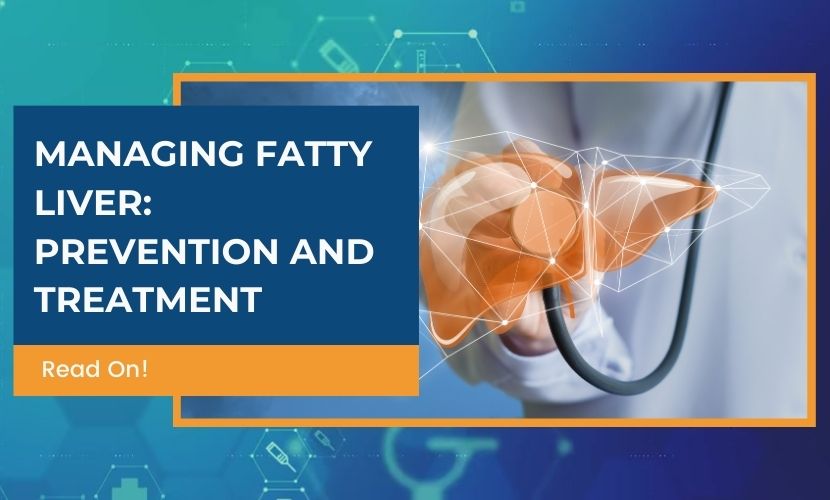Managing Fatty Liver: Prevention and Treatment

While liver disease consists of conditions like viral hepatitis, cirrhosis, and cancer, non-alcoholic steatohepatitis (NASH) is one form that is gaining increasing concern. This silent disease often goes undiagnosed until it has advanced, highlighting the importance of awareness. Understanding fatty liver disease, its development, and how to take control of your health can help to prevent this potentially serious condition.
Understanding NASH and Its Impacts
Non-alcoholic steatohepatitis (NASH), also known as fatty liver, is a more severe form of non-alcoholic fatty liver disease (NAFLD), which is estimated to affect about 25% of the adults in the U.S. While NAFLD refers to excess fat in the liver not caused by alcohol, NASH or fatty liver involves inflammation and cell damage in addition to the accumulation of fat. This inflammation can lead to liver scarring (fibrosis), which can lower its ability to function properly.
- Steatosis: This is the initial stage of NAFLD. Fat accumulates in the liver, but no inflammation or damage occurs. This stage usually presents without symptoms and is often discovered during routine health checks.
- NASH or fatty liver: Involves inflammation and cell damage alongside fat accumulation. Symptoms may still be absent, but some people might experience fatigue, unexplained weight loss, or discomfort in the right upper section of the abdomen.
- Fibrosis: If a fatty liver is left unaddressed, the inflammation can trigger scar tissue formation (fibrosis) in the liver. This eventually replaces healthy liver tissue, decreasing its ability to function normally.
- Cirrhosis: As fibrosis increases, it can lead to cirrhosis, a severe condition where healthy liver tissue is largely replaced by scar tissue, significantly impacting liver function. Symptoms like jaundice (yellowing of the skin and eyes), fluid buildup in the abdomen (ascites), and confusion can become noticeable at this stage.
- Liver failure and liver cancer: In the most severe cases, cirrhosis can eventually lead to liver failure, where the liver cannot function effectively. Also, people with advanced fatty liver have an increased risk of developing liver cancer.
Metabolic Syndrome and Fatty Liver
Metabolic syndrome is a group of conditions that can increase the risk of developing fatty liver. These conditions include:
- Obesity: Being overweight or obese is a major risk factor for fatty liver. The risk increases as weight increases.
- Type 2 diabetes: People with type 2 diabetes are more likely to develop fatty liver due to a problem with insulin sensitivity and sugar metabolism.
- High blood pressure: Chronic high blood pressure can contribute to damage and inflammation in the liver, increasing the risk of fatty liver.
- Abnormal cholesterol levels: High levels of LDL (“bad”) cholesterol and low levels of HDL (“good”) cholesterol can lead to fat accumulation and inflammation in the liver. This can eventually cause the development of fatty liver.
Early Detection Matters
One of the most challenging facts about fatty liver is the absence of specific symptoms in the early stages. This often leads to delayed diagnosis and potentially missed chances to intervene. However, being aware of the risk factors and early symptoms, such as fatigue, unexplained weight loss, or right upper abdominal discomfort, can encourage people to seek medical attention and get tested.
Early diagnosis and intervention are important for managing fatty liver effectively and preventing its progression to more severe complications. Lifestyle changes, such as maintaining a healthy weight, engaging in regular physical activity, and eating a balanced diet, can help those with fatty liver improve their liver health and prevent further damage.
The Role of Modern Lifestyles in Fatty Liver Disease
Today’s modern lifestyles, filled with poor food choices and sedentary lifestyles, have become a major factor in developing fatty liver disease:
Diet
- Processed foods: Processed foods are readily available and often more affordable than fresh foods. They are often filled with fats, added sugars, and carbohydrates, contributing to excess calorie consumption. These ”empty calories” offer little nutritional value while promoting fat storage, including in the liver.
- Sugar overload: Sugary drinks, desserts, and sugars in processed foods contribute to excessive sugar intake. The liver plays an important role in metabolizing sugar, but too much sugar can overwhelm its ability to do this, leading to fat accumulation and may contribute to inflammation.
- Fiber deficiency: Modern diets often have low amounts of fiber, which is important in regulating blood sugar, managing cholesterol levels, and making us feel full. A lack of fiber in the diet can contribute to insulin resistance, a key factor in fatty liver disease.
Physical Activity
- Sedentary lifestyle: The lack of physical activity reduces our body’s ability to use energy and burn calories, leading to fat storage in various tissues, including the liver.
- Decreased NEAT (Non-exercise Activity Thermogenesis): NEAT refers to the calories burned through daily activities like walking and taking the stairs. Our modern lifestyle often involves significantly reduced NEAT compared to past generations who were more active. This can further contribute to an imbalance in how calories are used in our bodies.
Other Factors
- Stress: Chronic stress can elevate cortisol levels, which can promote fat storage in the liver.
- Sleep deprivation: Not getting enough sleep can disrupt hormonal balance, including insulin sensitivity, potentially contributing to fatty liver disease.
- Environmental toxins: Exposure to environmental toxins, such as certain pesticides and industrial chemicals, can contribute to liver damage.
Recognizing that these factors often co-exist and interact is crucial. A poor diet, physical inactivity, and other contributing factors create a recipe for excess fat storage, inflammation, and, ultimately, potential liver damage.
Taking Control of Your Health
The good news is that even in the face of these challenges, we have the power to take control of our health and prevent or manage fatty liver disease. By adopting healthy lifestyle habits, we can significantly reduce our risk and promote overall well-being:
Liver-Friendly Diet
- Focus on unprocessed foods: Choose fruits, vegetables, whole grains, legumes, and lean protein whenever possible. These foods are rich in essential nutrients and fiber that can help support your digestion. They can make you feel full sooner and help you maintain a normal blood sugar level.
- Choose healthy fats: Pick healthy fats like those found in olive oil, avocado, nuts, and certain seeds. These provide essential nutrients and can support healthy cell function.
- Limit sugar: Restricting these items helps reduce excess calorie intake, manage sugar levels, and minimize inflammation.
Maintain a Healthy Weight
Develop healthy eating habits and regular physical activity to achieve and maintain a healthy body weight. Even smaller amounts of weight loss (5-10% of body weight) can improve liver health.
Get Moving Regularly
Try getting at least 150 minutes of moderate-intensity exercise or 75 minutes of high-intensity exercise each week. Taking part in any form of physical activity is great, so look for activities you enjoy and incorporate them into your daily routine.
Limit Alcohol and Avoid Toxins
- Consider decreasing your alcohol consumption, and ask your healthcare provider for guidance on safe limits.
- Think about your environmental exposure to toxins and look for ways to avoid them whenever possible.
Manage Stress and Prioritize Sleep
- Develop healthy stress management techniques like yoga, meditation, spending time taking walks, or doing things that you find enjoyable.
- Get 7-8 hours of quality sleep each night to promote optimal physical and mental health.
Keep On Top of Your Health
- Schedule regular check-ups with your healthcare provider to discuss any risk factors that you might have.
- If you’re at risk, consider getting a FibroScan® or other tests as your doctor recommends.
By making a few changes now, avoiding the negative effects of our modern lifestyle and keeping your liver healthy is possible. Remember, taking charge of your health can have a big impact on your long-term well-being.
Joining Studies and Seeking Support
If you’re concerned about your liver health or believe you might be at risk for fatty liver, taking part in clinical studies can be a proactive step. Research studies offer valuable information and can provide access to the latest updates.
Wake Clinical Research actively conducts fatty liver studies and offers eligible participants free FibroScan evaluations. Joining a study helps increase your overall understanding of fatty liver disease and can directly benefit you. You will also have the benefit of being able to monitor your liver health closely.
Key Takeaways
While fatty liver disease is a serious health issue, it can often be prevented and managed with lifestyle changes. Being aware of the risk factors and taking steps to live a more liver-friendly lifestyle can significantly reduce your chances of developing this condition.
Remember, it’s never too late to make positive changes to your health. If you think that you may have fatty liver disease or that you are at risk, speak to a healthcare provider and consider getting a free FibroScan through Wake Clinical Research.
References
- NASH Definition and Prevalence. American Liver Foundation. https://liverfoundation.org/liver-diseases/fatty-liver-disease/nonalcoholic-steatohepatitis-nash/nash-definition-prevalence/#:~:text=It’s%20estimated%20that%20about%2025,NAFLD%20have%20simply%20fatty%20liver.
- Non-Alcoholic Fatty Liver Disease (NAFLD) and Bariatric/Metabolic Surgery as Its Treatment Option: A Review, National Library of Medicine. National Center for Biotechnology Information. https://www.ncbi.nlm.nih.gov/pmc/articles/PMC8706342/.
- Levine JA. Non-exercise activity thermogenesis (NEAT). Best Pract Res Clin Endocrinol Metab. 2002 Dec;16(4):679-702. https://pubmed.ncbi.nlm.nih.gov/12468415/
- NASH Treatment. American Liver Foundation. Nonalcoholic Fatty Liver Disease and Nonalcoholic Steatohepatitis Treatment
- Kudaravalli P, John S. Nonalcoholic Fatty Liver. [Updated 2023 Apr 7]. In: StatPearls [Internet]. Treasure Island (FL): StatPearls Publishing; 2024 Jan-. Available from: Nonalcoholic Fatty Liver.


